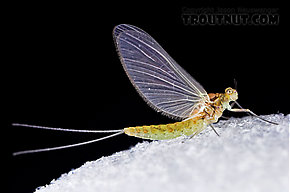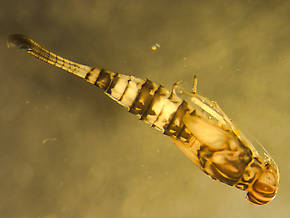Blog & Latest Updates
Fly Fishing Articles
Insects by Common Name


Mayfly Genus Procloeon (Tiny Sulphur Duns)
Taxonomic Navigation -?-
Kingdom
Animalia (Animals)
» Phylum
Arthropoda (Arthropods)
» Class
Insecta (Insects)
» Order
Ephemeroptera (Mayflies)
» Family
Baetidae (Blue-Winged Olives)
» Genus Procloeon (Tiny Sulphur Duns)
14 species aren't included.
Common Names
These mayflies may be abundant enough to cause fishable hatches in spite of their tiny size.
It's difficult to discern from previous angling literature exactly which statements now apply to Procloeon, because its species come from other little-known genera and the accounts for them conflict. They were mentioned in combination with other genera, adding to the confusion. So the information below is highly tentative and, where accounts seem to conflict, both have been given.
Where & When
Time Of Year (?): Mostly summer
Preferred Waters: Best in alkaline (Alkaline: Having a pH higher than 7 (opposite of acidic). Moderately alkaline water is ideal for trout because it's better for the growth of phytoplankton, the usual base of the aquatic food chain, and that's good for the growth of everything higher up the chain, including trout.) streams
Hatching Behavior
Trout may feed well on the tiny nymphs during a hatch. Caucci and Nastasi discovered and noted in Hatches II that these nymphs, despite their excellent swimming ability most of the time, become nearly immobile shortly before hatching. They slowly crawl out of the water or dead-drift (Dead-drift: The manner in which a fly drifts on the water when not moving by itself or by the influence of a line. Trout often prefer dead-drifting prey and imitating the dead-drift in tricky currents is a major challenge of fly fishing.) float to the surface, buoyed by gases they release.
According to one source, the duns crawl out onto shore to emerge.
Spinner Behavior
Procloeon duns usually molt into spinners, mate, and die the very day they hatched. Dun and spinner activity may overlap.
Nymph Biology
Current Speed: Slow
Substrate: Many, but weeds are best
They either prefer fertile, weedy spring creeks, or slow, silty stretches of relatively warm trout rivers, depending on which books should be believed.Substrate: Many, but weeds are best
Pictures of 2 Mayfly Specimens in the Genus Procloeon:
Female Procloeon (Tiny Sulphur Duns) Mayfly Dun View 8 PicturesThis dun of a fairly large Baetidae species was one of only a couple I saw all evening.
View 8 PicturesThis dun of a fairly large Baetidae species was one of only a couple I saw all evening.
 View 8 PicturesThis dun of a fairly large Baetidae species was one of only a couple I saw all evening.
View 8 PicturesThis dun of a fairly large Baetidae species was one of only a couple I saw all evening.Collected August 24, 2006 from Enfield Creek in New York
Added to Troutnut.com by Troutnut on August 27, 2006
Added to Troutnut.com by Troutnut on August 27, 2006
Procloeon pennulatum (Tiny Sulphur Dun) Mayfly Nymph View 1 PicturesThis fragile nymph is easily damaged during sampling making identification more difficult.
View 1 PicturesThis fragile nymph is easily damaged during sampling making identification more difficult.
 View 1 PicturesThis fragile nymph is easily damaged during sampling making identification more difficult.
View 1 PicturesThis fragile nymph is easily damaged during sampling making identification more difficult.Collected June 19, 2009 from Murphy Lake in Montana
Added to Troutnut.com by Bnewell on June 26, 2011
Added to Troutnut.com by Bnewell on June 26, 2011
Your Thoughts On Procloeon:
Top 10 Fly Hatches
Top Gift Shop Designs
Eat mayflies.
Top Insect Specimens
Miscellaneous Sites
Troutnut.com is copyright © 2004-2024 Jason
Neuswanger (email Jason). See my FAQ for information about use of my images.
 privacy policy
privacy policy
